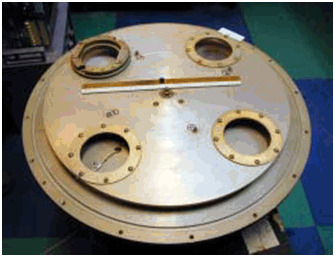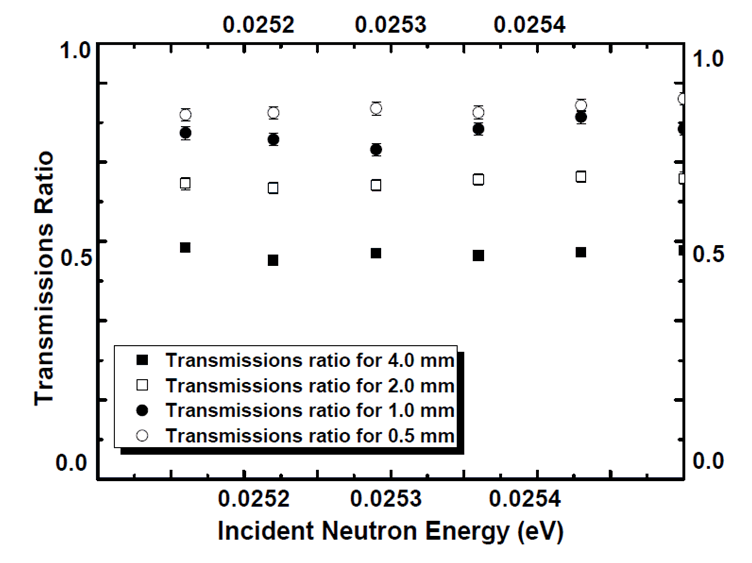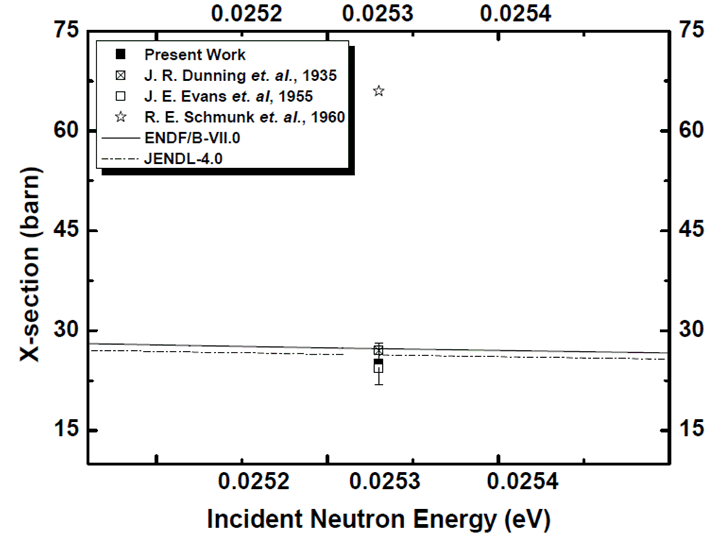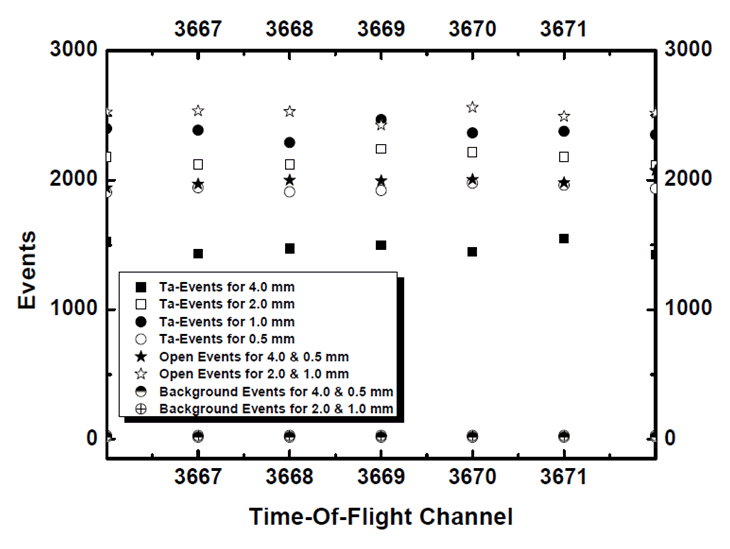-
Paper Information
- Next Paper
- Paper Submission
-
Journal Information
- About This Journal
- Editorial Board
- Current Issue
- Archive
- Author Guidelines
- Contact Us
Journal of Nuclear and Particle Physics
p-ISSN: 2167-6895 e-ISSN: 2167-6909
2011; 1(1): 1-5
doi: 10.5923/j.jnpp.20110101.01
Thermal Cross-Section of Naturally Occurring Tantalum
A. K. M. Moinul Haque Meaze
Department of Physics, University of Chittagong, Chittagong, 4331, Bangladesh
Correspondence to: A. K. M. Moinul Haque Meaze , Department of Physics, University of Chittagong, Chittagong, 4331, Bangladesh.
| Email: |  |
Copyright © 2012 Scientific & Academic Publishing. All Rights Reserved.
Neutron induced thermal cross-section of naturally occurring Tantalum (Ta) has been analyzed by using four different Ta samples with thickness 4.0, 2.0, 1.0 and 0.5 mm (respectively equivalent to 0.0224, 0.0111, 0.0055, and 0.0025 atoms/barn) at the Pohang Neutron Facility, Republic of Korea. The PNF consists of a 100 MeV electron linear accelerator (LINAC), a water cooled Tantalum (Ta) target, 12.06 m TOF path length, four position automatic sample changer controlled remotely by the CAMAC data acquisitions systems, and a 6LiZnS(Ag) inorganic scintillator as a neutron detector. The distance from the water cooled Ta target to the sample changer is 5.4 m. To reduce the gamma flash originated from the neutron target we have employed a neutron-gamma separation system based on their different pulse shape. The samples were highly pure (~99.9 %). In order to estimate the background and also to calibrate the energy we used notch filter of Cobalt (Co), Indium (In), and Cadmium (Cd) that has a large resonance peaks within our analyzed energy region. The area of the each samples of notch filter was 100 × 100 mm, and the thickness were 0.5 mm for Co and Cd; and 0.2 mm for the In. To get more events, experiments were done around 110 hours. The unwanted events were deleted from the real events by fitting with black resonances events of notch filter. The weighted mean of the measured thermal total neutron cross-section of Ta was compared with the existing experimental as well as evaluated nuclear data files.
Keywords: Thermal Cross-Sections, Electron Linear Accelerator, Neutron Detector
Cite this paper: A. K. M. Moinul Haque Meaze , "Thermal Cross-Section of Naturally Occurring Tantalum", Journal of Nuclear and Particle Physics, Vol. 1 No. 1, 2011, pp. 1-5. doi: 10.5923/j.jnpp.20110101.01.
Article Outline
1. Introduction
- Our knowledge of neutron cross-section in thermal energy zone is more complete than any other energy zone. This is because of easy getting high thermal neutron flux and concentrated of many dedicated workers. Generally there are many data of thermal cross-sections for most of the elements. However, in the case of Tantalum, unfortunately the results are few.Tantalum is a rare, shiny, gray, dense metal which is highly corrosion resistant. It is an excellent conductor of heat and electricity. Tantalum is used in the electronics industry for capacitors and high power resistors. It is also used to make alloys to increase strength, ductility and corrosion resistance. The metal is used in dental and surgical instruments and implants, as it causes no immune response. For the neutron target it is used in different facilities. Its high melting point and super conducting properties have made it in many metallic applications as well including filaments, wires, and acid-proof chemical equipments. It’s also used to make a variety of alloys with desirable properties such as high strength, good ductility, etc. Ta also used in surgical instruments and implants because it does not reactwith body fluids.Due to these huge applications and few experimental fluctuated thermal data we measured Ta for different energy regions. We already published[1] Ta total cross-sections and resonance parameters from 0.01 to 100 eV by using only one sample and also we showed only the data trend and hence we did not able to show exact cross-section in thermal point. Here we used four different Ta sheets in order to locate the exact thermal value.J. R. Dunning et. al.[2] published thermal total cross-section of Ta is 27 barn in 1935. The interaction of this thermal neutron with matter was studied at Colombia University and the error of their result is around 10%. At the Material Testing Reactor Crystal Spectrometer, USA, J. E. Evans et. al.[3] reported their thermal value is 24.3 barn in 1955. The last experimental thermal cross-section was published in 1960[ 4] and their result is almost three times higher than previous data. The nuclear data libraries[5,6] were also used different values for the reproducing of the Evaluations.For this measurements we carried out transmission experiments on four metallic tantalum sheets with different thickness because sample thickness is of great importance in transmission measurements. Sample must be enough thick to provide a detectable amount of interactions and not too thick then the entire neutron beam interacts with the sample. As the thickness needed to provide the accurate transmissions and hence cross-sections, so we analyzed different Ta samples. Finally we have taken weighted mean value andcompared with others.
2. Experimental Facility
- The experiment was done at the Pohang Neutron Facility of Pohang Accelerator Laboratory , South Korea.The PNF consists of a 100 MeV electron linac, water-cooled Ta target and a 12 m long evacuated flight tube. The electron linac consists of a thermionic RF-gun, an alpha magnet, four quadruple magnets, two SLAC-type accelerating sections, a quadruple triplet and a beam-analyzing magnet. The overall length of the linac is about 15 m. As a photo-neutron target, it is necessary to use heavy mass materials in order to produce intense neutrons by way of Bremsstrahlung under high-power electron beams. We have chosen a tantalum as the target material, which has advantages of high density (16.6 g-cm-3), high melting point (3017℃) and high resistant against the corrosion by cooling water. The TOF tubes were made by stainless steel with two different radii of 7.5 and 10 cm. The neutron beam line was equipped with a four–position sample changer that can allow the simultaneous total cross-section measurement for four different samples. The sample changer is a disc with four symmetrically round holes; each one is of 8 cm in diameter. The system rotates relatively to its own central axis and allows automatically the accumulation of data from up to four different samples in one run after setting the time exposition time individually for each sample. Thus, the sample changer provides economic and timesaving measurement. Moreover, the automatic control allows avoiding the systematic errors due to the fluctuation of the neutron beam intensity. The four-position sample changer can be used with different samples: solid samples as well as liquid or powder ones shrouded in special cassettes. The disc cover has two control and management windows and another one for samples downloading. All of them are transparent and pressurized. The beam transmission windows – one in the fixed disk of SC, another in a top of cover are covered with aluminum foil and pressurized also. The movement of the mobile disk with samples is performed by the electric motor with the build – in reduction gearbox. The time of movement between two neighboring positions is 10 sec. The sample changer shown in Fig 1.
 | Figure 1. Four position sample changer |
3. Data Taking and Processing
- In the measurements period the exposition times for samples Ta were 15 minutes (9000 pulses of PNF linac); for empty position, it was also 15 minutes. Thus, the duration for the sample was the same as those for the total open beam measurements. The interleaving sequence of free position of the sample changer was chosen to minimize the influence of slow and (/or) small variation of the neutron beam intensity. If the beam intensity variations or its drift was fast and (/or) large, then these partial measurements were excluded from the total statistics. The total data taking times and Ta were 48.75 and 61.25 hrs, respectively for 4.0, 0.5 mm and 2.0, 1.0 mm thickness. It means we used beam on 4.0 mm and 0.5 mm Ta, and after that on 2.0 and 1.0 mm Ta in different period. We also used Notch Filter to denote black resonances, and finally to subtract background by the fitting procedure[9].
 | (1) |
 | Figure 3. Transmission coefficients for the different Ta samples. It is seen that the thinner the samples, coefficients are larger |
 | (2) |
 | (3) |
 | (4) |
4. Results
- The thermal cross-sections for the naturally occurred Tantalum of thickness 4.0, 2.0, 1.0 and 0.5 mm are respectively 24.46 ± 5.11, 26.94 ± 6.44, 22.15 ± 7.00, 26.73 ± 6.81 (barn). The weighted mean of these results is 25.05 ± 3.10 (barn). This mean result along-with other available results are plotted in Fig. 4.
 | Figure 4. Thermal cross-section of Tantalum |
5. Conclusions
- The Pohang Neutron Facility (PNF) in Korea, which consists of a 100 MeV Linac, with a Ta target, surrounded by the water moderator, and 12.06 m flight path has been used for the measurement of thermal total cross-sections of natural Tantalum for the incident energy 0.0253 eV.To observe the effect of thickness we carried out transmissions experiments for four different tantalum metallic sheets with thickness 4.00, 2.00, 1.00, and 0.45 mm. The thicker the sample, the more sensitive data observed to the cross-section structure. These are more sensible to the total cross section between resonances and especially to the resonance wings. Therefore we have taken cross-section of the weighted mean of the thermal energies.The present result is almost similar to the results of J. R. Dunning et. al.[2], J. E. Evans et. al.[3] and Japanese Evaluated Reaction Data file JENDL-4.0[6]. American Evaluate Reaction Data ENDF/B-VII.0[5] is slightly higher and R. E. Schmunk et. al.[4] data is 2.6 times higher than present result.From the time-of-flight spectra of all Ta samples we see (in Fig. 2) that for the same time measurements for the sample of thicker thickness the number of events are higher than thinner thickness. If the thickness difference is more than the more difference is observed. Therefore, thickness is very important to get the exact cross-section. As we have used four different high purity tantalum samples and beam was carried on them for long time so the result is more reliable. In the results section we have shown only the statistical error. The correlated error contains mainly on errors of flight path, target density, sample impurity etc which is less than 5%. The total error is less than 7%.
ACKNOWLEDGEMENTS
- The author would like to express his sincere thanks to the staff of the Pohang Accelerator Laboratory for the excellent machine operation. The author would also like to thanks Prof. Guinyun Kim and Dr. Young Seok Lee for their wonderful cooperation and fruitful discussions.
 Abstract
Abstract Reference
Reference Full-Text PDF
Full-Text PDF Full-Text HTML
Full-Text HTML